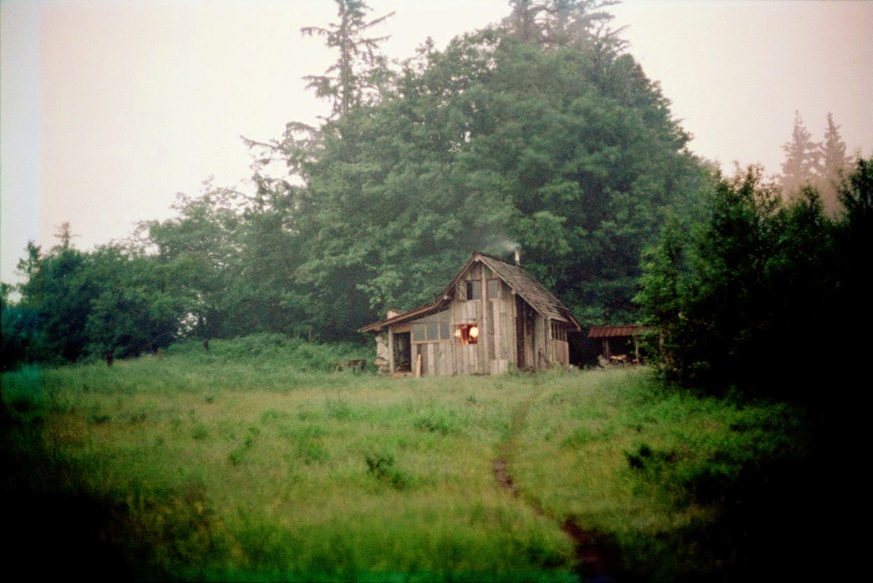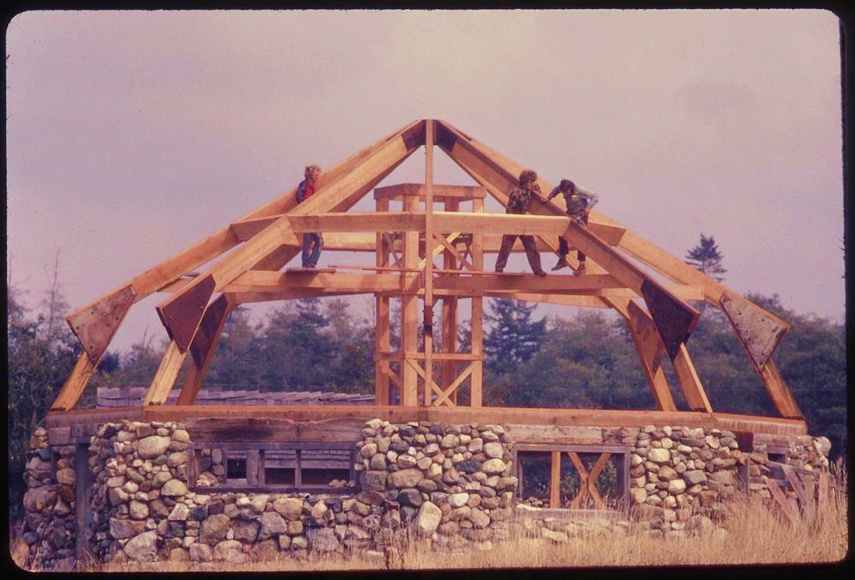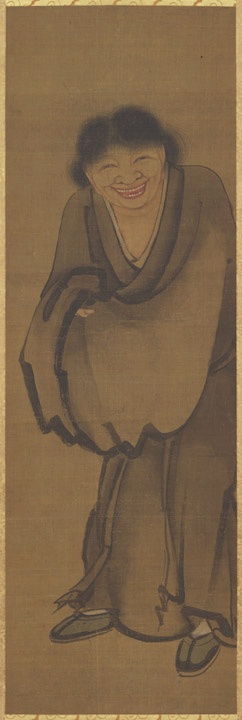JONES FARM – Late sixties to Early Seventies- by Barrie Mottishaw
In the spring of 1969 a small group of college students arrived on Quadra Island, British Columbia, Canada at the invitation of Janet Jones, pottery instructor at Antioch College in Yellow Springs, Ohio. They were potters, film makers, painters, sculptors, poets, carpenters, welders. The year before Janet had purchased a quarter section of land - 160 acres – at the southern tip of Quadra Island in the area known as Francisco Point. This was an old pioneer homestead. It had a main house which was nothing special, out buildings including a root cellar which we Jones Farmers took to calling “The Bomb Shelter”, a working well. But it also had a large nineteenth century orchard with mature trees – many heirloom varieties of English apples, pears, plums, and a few hazelnut trees as well. A large open field faced the Strait of Georgia. The field ended at the rim of a hundred and sixty foot cliff and on a clear day, standing at cliff’s edge, you could see for hundreds of miles across the water - to the mountains of Vancouver Island on the right, the peaks of the mainland mountains on the left. And, because Quadra is one of an archipelago of islands that lie between Vancouver Island and the mainland of B. C., you would also see the various shapes of some of the other Douglas fir covered islands, the nearer ones showing their strong contrasting colours of gray, green, and black, the more distant ones paler, gauzy in a spectral hazy blue. It was magical.

Mottishaw House on the Jones Farm, Quadra Island, ca. 1970
Larry and Laurie Hansen arrived in late June of ’69. They had come from San Francisco at the invitation of Molly Jones, Janet’s daughter. They had all three been students of Suzuki Roshi, Larry and Molly at Tassajara, Laurie in the city. Molly had invited Larry to come to help build her mom Janet’s studio – actually Janet’s idea was to build a communal studio which she envisioned as the central hub of an extensive arts community.
In the States, the Vietnam War was dragging on. College students just finishing their studies were getting called up for their draft physicals. Massive demonstrations and acts of civil disobedience dominated the news and desertions from the military forces were becoming common. But the country was finally turning against the War. In such a political climate, leaving for Canada seemed a good idea.
John Mottishaw failed his draft physical in spring 1969 and he, Barrie Deigh, and Rick Patton – all three from Antioch College – hitchhiked up to the Jones Farm in early July. At first, they camped in the orchard, but later the three went back to Seattle, J & B returning in their khaki coloured VW bus and Patton in his 1949 pickup truck. Soon there would be more incomers - a steady stream of young people moving onto the land as word about the new community spread. Larry, Laurie, and Molly Jones had many friends from Tassajara who came: Jeff Broadbent, Bill Benz, Dan Chesluk, Martha Trundy, Tim Aston are the people I can remember arriving. Some visited for a few weeks or months. Others took up permanent residency. The community at that time 1969 - 1972 was about half Antiochian art students or recent graduates, and half Suzuki Roshi students from Tassajara and Zen Center in San Francisco.
We ate communal meals in the main house. Larry built a low table and we brought stumps up from the beach for seating. We ate Japanese style around the low table: brown rice, shellfish -- both oysters and clams – they were plentiful at low tide down below. Rock cod, red snapper, flounder: all were in abundance. We fished with a cod jig on a thick monofilament line, pulling the fish across the side of the skiff or canoe hand over hand. Larry made gomashio and his specialty, Tibetan Barley Bread, on occasion. We grew a garden – the homestead had a large garden plot – getting gardening tips from our nearest island neighbour, Estelle Rose – who lived just down the road. Vegetables and fruits were supplemented during our “town trips” to Campbell River (the logging and mill town on Vancouver Island) a short ferry ride away. After doing the community laundry at the laundromat, we would visit the supermarket’s loading dock. Out back, where the “past-the-sell-by- date” produce was set out, we picked up boxes of fruit and vegetables. (We suspected some of it was deliberately set out for us).

Building the Stone Studio, The Jones Farm, Quadra Island, ca. 1970
Larry and Laurie built their house behind the main house. It had been an old shed, but Larry made it into a cozy dwelling with a kind of top knot on the roof. John and I built a driftwood house north of the main house along the bluff. It started out as an 8 x 10’ structure with a loft. (Later, we added on another room toward the cliff edge for a little studio/work room.) To find our building materials originally, we travelled the beach, collecting dock planks which had washed up. We pulled them over the cliff with the Jones Farm tractor, stood them on end at our house site, nailed them to a structure of fir and hemlock poles - and scavenged 2 x 4s -, and caulked the seams with oakum (a wooden boat caulking material made from twisted jute impregnated with creosote). Windows were also scavenged. Our total outlay for our building materials was $100, mostly for nails and glass. The oakum was a gift from the Q Cove Boatworks where John had gotten a job repairing wooden fishing boats used for salmon fishing, an important local industry at the time. Two other cabins were built: an a-frame located a quarter mile north of the Mottishaw house, and a log house in the woods across the road from the main house.
Larry and a few other men built what was designed to be the future kiln shed, but as there was no pottery being made yet, he fitted it out as our zendo. Larry was Ino, gathering all who wanted to sit into a small sangha. He made a han – it hung from the front porch - and he also obtained a mokugyo from San Francisco. There was regular sitting every day and Roshi sent Silas Hoadley up to Quadra several times a year to conduct our sesshins.
Tragically, at the end of our first summer, on September 17th, Janet Jones was killed when her flight into Campbell River misjudged the airport runway in a freak September storm. The pilot and co-pilot were also killed. All the other passengers were able to walk off the plane unharmed.
Losing Janet changed things for us. Suddenly Michael and Molly Jones, both in their 20s, inherited the land; their father had died many years earlier. They inherited the land as well as the shifting collection of Suzuki Roshi students, Antiochians, and assorted other travellers and hippies. It took them a few years to figure out what they wanted to do. Meanwhile, as we were in limbo, we just kept moving ahead, building the studio, planting the garden, having communal meals, sitting zazen.
John and I left the farm in the Fall of 1972 for Cortes Island, the adjacent island to the east towards the mainland. Our daughter, Petra, had just turned two. We left in our new-to-us used Willeys jeep as well as a new-to-us 1959 hunter green four door Mercedes sedan, both vehicles bought from the same guy on Quadra, a “shakey”, i.e., a guy who owned a mill for making cedar shakes and shingles.
To buy the 160 acres of land on Cortes, we partnered with another couple from Big Sur (one of the couple was an Antioch graduate). At that time, Cortes Island was home to 400 permanent residents, mostly loggers and fishermen and their families. It was more remote than Quadra. The island had just gotten electricity and also a ferry; the boat ran only two days a week to Quadra. Cortes was the new home of Cold Mountain Institute, founded by Richard Weaver and his wife, Jean, from Esalen. The name “Cold Mountain Institute” was taken from a poem by Han Shan, a Chinese Zen poet of the 9th century. There was a brush painting of Han Shan hanging in the entryway to Cold Mountain’s main lodge.
Poem by Han Shan
I’m on the trail to Cold Mountain.
Cold Mountain trail never ends.
Long clefts thick with rock and stones,
Slippery moss, but there’s been no rain,
Pine trees sigh, but there’s no wind.
Who can leap the world’s net,
Sit here in the white clouds with me?

“Cold Mountain’s programming was a mix of Gestalt therapy, encounter groups, with a sprinkling of Buddhism.” (from an article on Cold Mountain and Richard Weaver, Peter Wrinch, 2019.) Martha Trundy, who had worked in the kitchen with Ed Brown at Tassajara, preceded us to Cortes from the Jones Farm the year before. She’d been hired by Jean Weaver to run the kitchen.
The fellow who sold us the Cortes property had been Cold Mountain’s Rolfer and he’d decided to move off the island and join up with some Sufis in New York City. All we had to do was come up with $5000 to make the next payment on the land, which the four of us did by borrowing it from our respective parents.
... I will end this here, as my subject has been primarily The Jones Farm. The Farm continued on for a few years, losing some of its original settlers, and gaining others. A few years later, Michael and Molly Jones sold the property and the remaining residents dispersed.